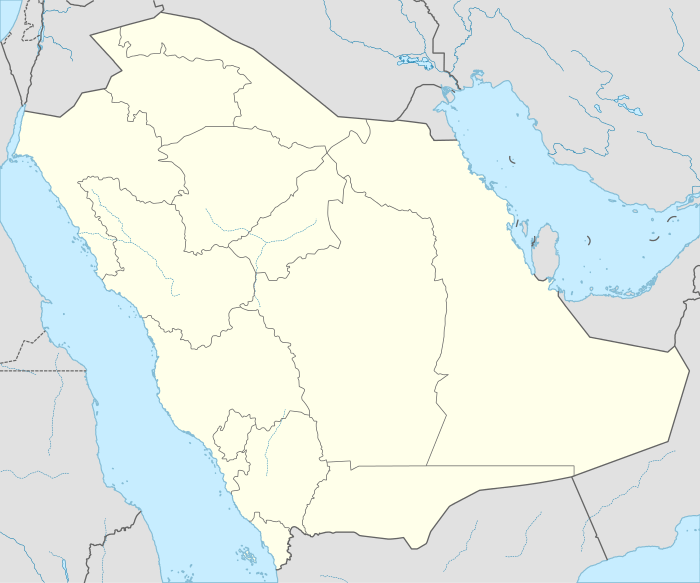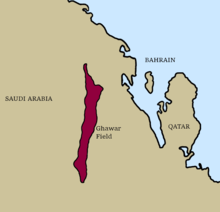Ghawar Field
Ghawar (Arabic: الغوار) is an oil field located in Al-Ahsa Governorate, Eastern Province, Saudi Arabia. Measuring 280 by 30 km (174 by 19 mi), it is by far the largest conventional oil field in the world,[1] and accounts for roughly a third of the cumulative oil production of Saudi Arabia as of 2018.[2][3]
| Ghawar Field | |
|---|---|
 | |
| Country | Saudi Arabia |
| Region | Eastern Province |
| Location | Al-Ahsa |
| Offshore/onshore | Onshore |
| Coordinates | 25.43°N 49.62°E |
| Operator | Saudi Aramco |
| Field history | |
| Discovery | 1948 |
| Start of production | 1951 |
| Peak year | 2005 (Contested) |
| Production | |
| Current production of oil | 3,800,000 barrels per day (~1.9×108 t/a) |
| Current production of gas | 2,000×106 cu ft/d (57×106 m3/d) |
| Estimated oil in place | 48,250 million barrels (~6.583×109 t) |
| Estimated gas in place | 110,000×109 cu ft (3,100×109 m3) |
| Producing formations | Upper/Middle Jurassic, Upper/Lower Permian, Lower Devonian |
| External images | |
|---|---|

Ghawar is entirely owned and operated by Saudi Aramco, the state run Saudi oil company. In April 2019, the company first published its profit figures since its nationalization nearly 40 years ago in context of issuing a bond to international markets. The bond prospectus revealed that Ghawar is able to pump a maximum of 3.8 million barrels a day—well below the more than 5 million that had become conventional wisdom in the market.[4][3]
Geology
Ghawar occupies an anticline above a basement fault block dating to Carboniferous time, about 320 million years ago; Cretaceous tectonic activity, as the northeast margin of Africa began to impinge on southwest Asia, enhanced the structure. Reservoir rocks are Jurassic Arab-D limestones with exceptional porosity (as much as 35% of the rock in places), which is about 280 feet thick and occurs 6,000-7,000 feet beneath the surface. Source rock is the Jurassic Hanifa formation, a marine shelf deposit of mud and lime with as much as 5% organic material, it is estimated that 1% to 7% is considered good oil source rock. The seal is an evaporitic package of rocks including impermeable anhydrite.[5]
History
In the early 1940s, Max Steineke, Thomas Barger and Ernie Berg noted a bend in the Wadi Al-Sahbah dry river bed. Measurements confirmed that the area had undergone geologic uplift, an indication that an oil reservoir may be trapped underneath. Oil was indeed found, in what turned out to be the southern reaches of Ghawar.[6]
Historically, Ghawar has been subdivided into five production areas, from north to south: 'Ain Dar and Shedgum, 'Uthmaniyah, Hawiyah and Haradh. The major oasis of Al-Ahsa and the city of Al-Hofuf are located on Ghawar's east flank, corresponding to the 'Uthmaniyah production area. Ghawar was discovered in 1948, and put on stream in 1951.[1][7] Some sources claim that Ghawar peaked in 2005, though this is denied by the field operators.[8][9]
Saudi Aramco reported in mid-2008, that Ghawar had produced 48% of its proven reserves.[10]
Production
Approximately 60–65% of all Saudi oil produced between 1948 and 2000, came from Ghawar. Cumulative production through early 2010, has exceeded 65 billion barrels (1.03×1010 m3).[2] In 2009, it was estimated that Ghawar produced about 5 million barrels (790,000 m3) of oil a day (6.25% of global production), a figure which was later shown to be substantially overestimated.[11][4]
As of 31 December 2018, a total of 58.32 billion reserves of oil equivalent including 48.25 billion barrels of liquid reserves have been confirmed by Saudi Aramco. Average daily production was 3,800,000 barrels per day.[3]
Ghawar also produces approximately 2 billion cubic feet (57,000,000 m3) of natural gas per day.[12]
The operators stimulate production by waterflooding, using seawater at a rate said to be around 7 million gal/day.[13] Water flooding is said to have begun in 1965.[14] The water cut was about 32% in 2003, and ranged from about 27% to 38% from 1993 to 2003.[15] By 2006, North Uthmaniyah's water cut was about 46%.[16][17]
Reserves
In April 2010, Saad al-Tureiki, Vice-President for Operations at Aramco, stated, in a news conference reported in Saudi media, that over 65 billion barrels (10.3 km3) have been produced from the field since 1951. Tureiki further stated that the total reserves of the field had originally exceeded 100 billion barrels (16 km3).[18]
The International Energy Agency in its 2008 World Energy Outlook stated that the oil production from Ghawar reached 66 Bbo in 2007, and that the remaining reserves are 74 Bbo.[11]
Matthew Simmons, in his 2005 book Twilight in the Desert, suggested that production from the Ghawar field and Saudi Arabia may soon peak.[19]
When appraised in the 1970s, the field was assessed to have 170 billion barrels (27 km3) of original oil in place (OOIP), with about 60 billion barrels (9.5 km3) recoverable (1975 Aramco estimate quoted by Matt Simmons). The second figure, at least, was understated, since that production figure has already been exceeded.[19]
See also
- Udhailiyah, residential compound built atop the central part of Ghawar
- Khurais oil field
- List of oil fields
- Peak oil
- Swing producer
References,
- Louise Durham (January 2005). "The Elephant of All Elephants". AAPG Explorer. Archived from the original on March 2, 2006.
- "The Ghawar Oil Field, Saudi Arabia". Gregcroft.com. Retrieved 2013-04-15.
- "Saudi Arabian Oil Company - Global Medium Term Note Programme" (PDF). Saudi Arabian Oil Company. April 1, 2019. Retrieved April 4, 2019.
- "Bloomberg - Are you a robot?". www.bloomberg.com. Retrieved 2019-04-04.
- Finding Ghawar: Elephant Hid in Desert By Rasoul Sorkhab, AAPG Explorer, June 2011
- Al-Naimi, Ali (2016). Out of the Desert. Great Britain: Portfolio Penguin. p. 20. ISBN 9780241279250.
- Glenn Morton (2004-07-24). "Trouble in the World's Largest Oil Field-Ghawar". Energy Bulletin.
- Donald Coxe (2005-03-31). "Has Ghawar truly peaked?".
- Porter, Adam (April 12, 2005). "Bank says Saudi's top field in decline". English Al-Jazeera. Archived from the original on 2006-08-13. Retrieved 2006-09-05.
- "Saudi Arabia Energy Data, Statistics and Analysis - Oil, Gas, Electricity, Coal". 2008-08-01.
- The King of Giant Fields by Rasoul Sorkhab, GeoExPro Issue 4, Volume 7, 2010
- "Top Ten Highest Producing Oil Fields". Oil Patch Asia. Archived from the original on 2 January 2014. Retrieved 7 January 2014.
- Saudi Arabia's Giant Ghawar Oil Field, Global Resources News
- Ghawar Oil Field: Saudi Arabia's Oil Future by Justin Williams, February 19th, 2013
- Source: A.M. Afifi, 2004 AAPG Distinguished Lecture, chart reproduced in Rasoul Sorkhab, 2010.
- Peak oil isn’t dead: An interview with Chris Nelder
- Tech Talk - Current Oil Production and the Future of Ghawar
- "أرامكو: "الغوار" ما زال قويا بـ"100" مليار برميل". 2010.
- Simmons, Matthew (2005). Twilight in the Desert - The coming Saudi oil shock and the world economy. Hoboken, NJ: John Wiley & Sons. ISBN 0-471-73876-X.
Further reading
- Arabian American Oil Company Staff, "Ghawar Oil Field, Saudi Arabia", Bulletin of the American Association of Petroleum Geologists, Vol 43, No. 2 (February, 1959), pp 434–454. Still the basic public reference for Ghawar geology.
External links
- Articles on Ghawar and analysis on its reserves from The Oil Drum
- Terrorists and Ghawar
- Saudi Aramco official website (source of most data in this article).
- World-beater Ghawar a field apart, 2008 article in Saudi Aramco Dimensions magazine